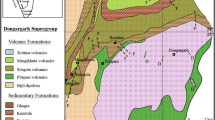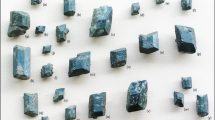Summary
The crystal-chemistry of clinopyroxene from a suite of Sunda arc volcanic rocks was investigated by X-ray structure refinement and microprobe analysis. Relationships with clinopyroxene from volcanic rocks of the intraplate environment were highlighted.
Sunda clinopyroxenes were distinguished into two groups. The first consists of clinopyroxene from SiO2-saturated rock types and crystal rim from SiO2-undersaturated rock types, the second of crystal core from SiO2-undersaturated rock types. The crystal chemical behaviour of the two groups differs significantly, mainly in the geometrical relationships between M2 and T sites. While in the first group 〈M2-O3〉 and 〈T-O3〉 bond lengths shorten and lengthen respectively due to Ca and AlIV increase, in the second group in which M2 site is almost fully coordinated by Ca, 〈-O3〉 bond lengths are forced to lengthen in spite of low AlIV content, in order to mantain the local charge balance around the O3 oxygens.
It is noteworthy that Sunda clinopyroxene shows strong analogies with that from basaltic rocks from the Ethiopian plateau and K-rich lavas from the Roman Province respectively, reflecting similarities between the composition and mineralogical assemblages of the host rocks, although they all came from different tectonic environments. A relationship between intracrystalline Mg-Fe 2+ disorder and the explosive character of the volcanism is demonstrated.
Zusammenfassung
Die Kristallchemie von Klinopyroxenen aus einer Serie von vulkanischen Gesteinen des Sunda-Bogens wurde mit Röntgen-Strukturverfeinerungen und Mikrosonden-analysen untersucht. Beziehungen zu Klinopyroxenen vulkanischer Gesteine aus intra-Plattenpositionen werden beleuchtet. Die Sunda-Klinopyroxene wurden in zwei Gruppen eingeteilt. Die erste umfaßt Klinopyroxene SiO2-gesättigter Gesteinstypen und Kristallsäume SiO2-untersättigter Gesteinstypen, die zweite Kristallkerne SiO2-untersättigter Gesteinstypen. Das kristallchemische Verhalten der beiden Gruppen unterscheidet sich beträchtlich, hauptsächlich in den geometrischen Beziehungen zwischen den M2 und T Positionen. Während in der ersten Gruppe die 〈M2-O3〉 und 〈T-O3〉 Bindungsldngen durch Zunahme von Ca und AlIV kleiner bzw. größer werden, sind in der zweiten Gruppe die 〈T-O3〉 Bindungslängen trotz niedrigen AlIV Gehaltes zu einer Vergrößerung gezwungen, damit um die O3 Atome der lokale Ladungsausgleich erhalten bleibt.
Es ist bemerkenswert, daß die Sunda-Klinopyroxene große Analogien zu denen aus basaltischen Gesteinen des Abessinischen Plateaus und aus K-reichen Laven sowohl der Römischen Provinz als auch des Westafrikanischen Grabens zeigen. Dies spiegelt Ähnlichkeiten zwischen Zusammensetzung und Mineralbestand der Muttergesteine wider, obwohl sie all aus tektonisch unterschiedlichen Positionen kommen.
Eine Beziehung zwischen intrakristalliner Mg-Fe2+ Unordnung und dem explosiven Charakter des Vulkanismus wird aufgezeigt.
Similar content being viewed by others
References
Bruno E, Carbonin S, Molin G (1982) Crystal structures on Ca-rich clinopyroxenes on the CaMgSi2O6-Mg2Si2O6 join. TMPM 29: 223–240
Burnham C W, Clark JR, Papike JJ, Prewitt CT (1967) A proposed crystallographic nomenclature for clinopyroxene structure. Z Krist 125: 109–119
Dal Negro A, Carbonin S, Molin GM, Cundari A, Piccirillo EM (1982) Intracrystalline cation distribution in natural clinopyroxenes of tholeiitic, transitional und alkaline basaltic rocks. In:Saxena SK (ed) Advances in physical geochemistry 2. Springer, Berlin Heidelberg New York, pp 117–150
Dal Negro A, Carbonin S, Salviulo G, Piccirillo EM, Cundari A (1985) Crystal chemistry and site configuration of the clinopyroxene from leucite-bearing rocks and related genetic significance: the Sabatini lavas, Roman Region, Italy. J Petrol 26: 1027–1040
Dal Negro A, Molin GM, Salviulo G, Secco L, Cundari A, Piccirillo EM (1989) Crystal chemistry of clinopyroxene and its petrogenetic significance: a new approach. In: the lithosphere in Italy advances in earth science research. Atti dei Convegni Lincei 80: 271–295
De La Roche H, Leterrier J, Grandclaude P, Marchal M (1980) A classification of volcanic and plutonic rocks using R1 vs R2 diagram and major-elements analysis. Its relationships with current nomenclature. Chem Geol 29: 183–210
Foden JD, Varne R (1980) Petrogenetic and tectonic implications of near coeval calccalkaline to highly alkaline volcanism on Lombok and Sumbawa islands in the eastern Sunda arc. ESCAP CCOP-IOC SEATAR ad hoc Working group Meeting, Bandung, Indonesia, 9–14 July (Abstract)
Molin GM, Zanazzi PF (1991) Intracrystalline Fe2+-Mg ordering in augite: experimental study and geothermometric applications. Eur J Mineral 3: 863–875
Morimoto, Chairman Subcommittee on Pyroxenes Commission on new mineral names IMA (1988) Nomenclature of pyroxenes. Mineral Petrol 39: 55–76
Robinson K, Gibbs GV, Ribbe PH (1971) Quadratic elongation: a quantitative measure of distortion in coordination polyhedra. Science 172: 567–570
Shannon RD (1976) Revised effective ionic radii and systematic studies of interatomic distances in halides and chalcogenides. Acta Cryst A32: 751–767
Author information
Authors and Affiliations
Rights and permissions
About this article
Cite this article
Salviulo, G., Molin, G.M. Crystal-chemistry of clinopyroxene from Sunda volcanic arc. Mineralogy and Petrology 49, 233–248 (1993). https://doi.org/10.1007/BF01164596
Received:
Accepted:
Issue Date:
DOI: https://doi.org/10.1007/BF01164596




